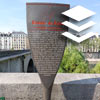One of the series of signs describing historical places in Paris. The signs were placed starting in 1992 and are also called sucettes Starck (Starck’s Lollipops) after Philippe Starck who designed them.
The sign depicts the home of General Jean Victor Marie Moreau (1813-1763), who fought in the wars that resulted from the French Revolution. Participated in the Coup of 18 Brumaire, the preparations for which took place in this house, and at the end of which the powers of government were transferred to Napoleon Bonaparte
The house was named after General Moreau, although he lived there for a short time (1799-1801).
The house is designated as a French historical heritage site, although no sign indicating this was found near the building.
The house was photographed on the same day
 Click for a larger image
Click for a larger image The illustration in the center of the sign is shown here at magnification
 Click for a larger image Translation of the text on the sign
Click for a larger image Translation of the text on the sign:
[An illustration of a ship, symbolizing the symbol of Paris]
History of Paris Hôtel Moreau In 1795, Jean-Baptiste Lakanal-Dupuget, a convinced royalist, had three hotels built: that of No. 20, located at the back of the courtyard, although deeply remodeled, has preserved a beautiful portico with columns, as well as the circular lounge with its Directoire style. Acquired in 1799 by General Moreau, it was the seat of the preparatory meeting for the coup d’état of 18 Brumaire.
In 1977, during retaining work, 364 sculpted stone blocks from the façade of Notre-Dame were uncovered, including twenty heads of colossal statues of the kings of Judah, brought down by the revolutionaries who took them for those of the kings. of France. Lakanal Dupuget would have piously recovered these sculptures, condemned to destruction; found, they were deposited in the Cluny museum.
[illustration of the house]

 Click for a larger image
Click for a larger image  Click for a larger image
Click for a larger image  Click for all signs belonging to The History of Paris (Starck's Lollipops)
Click for all signs belonging to The History of Paris (Starck's Lollipops)
 232 Meter |
232 Meter |  259 Meter |
259 Meter |  269 Meter |
269 Meter |  301 Meter |
301 Meter |  308 Meter
308 Meter